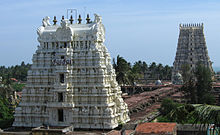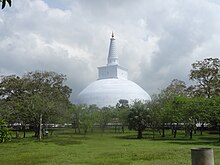| Pandyan Civil War | |||||||||
|---|---|---|---|---|---|---|---|---|---|
 Sinhalese troops ride into Southern India | |||||||||
| |||||||||
| Belligerents | |||||||||
|
|
| ||||||||
| Commanders and leaders | |||||||||
|
Kings
Commanders
|
Kings
Commanders
| ||||||||
| Units involved | |||||||||
|
|
| ||||||||
| Casualties and losses | |||||||||
| Some Tamil soldiers were killed and injured. | Sinhala commanders Lankapura Dandanatha, Jagathth Vijaya and their officers were killed king Parakrama Pandyan I with many number of his soldiers and many number of Sinhalese Soldiers were killed. | ||||||||
| Some Tamils captured from the war were brought to Sri Lanka to renovate the Ruwanwelisaya, Rameshvaram temple plundered by Sinhala army. | |||||||||
| Polonnaruwa period conflicts | |
|---|---|
The Pandyan Civil War from 1169 to 1177 was precipitated by rival claims of succession to the Pandyan throne. The Civil War began between Parakrama Pandyan and his nephew Kulasekhara Pandyan and lasted for the next 15 years between successive Pandyan kings. The war gradually spread to the rest of Southern India when the Chola King Rajadhiraja II and the Sinhalese King Parakramabahu I of Polonnaruwa entered the fray and took opposing sides in the conflict, eager to increase their influence in the Pandya kingdom.
In about 1169, Kulasekhara besieged Madurai, forcing the Pandyan king Parakrama I to appeal to the Sinhalese King Parakramabahu I for assistance. But before Parakramabahu I's army could reach Madurai, Parakrama I had been executed, and Kulasekhara Pandyan had ascended the throne. However, Parakrama's son, Vira Pandyan III, sided with the Polonnaruwa forces led by General Lankapura Dandanatha. The Polonnaruwa Army invaded the Pandyan kingdom and, Kulasekhara Pandyan was forced into exile.
Events
Prior to the war
Images of various gateway towers in the templeIn 1169, Kulasekhara Pandyan, a rival claimant of the Pandyan throne, besieged the Pandyan capital at Madurai. Pandyan king, Parakrama Pandyan I, had to call for military support from the King of Polonnaruwa, Parakramabahu I. By the time the Polonnaruwa Army was assembled for an invasion, it was too late. Parakrama Pandyan's position was overrun, and Kulasekhara ascended the throne as Kulasekhara Pandyan I. Parakramabahu I instructed his general Lankapura Dandanatha to invade Pandya and besiege Madurai, thus overthrowing Kulasekhara.

 Chola Territory before(left) and after(right) the war.
Chola Territory before(left) and after(right) the war.
Sinhalese offensive

The offensive began in 1171 or 1172; the Sinhalese Army and other units of Polonnaruwa led by Lankapura launched the attack on Ramesvaram. After sailing around the Palk strait for a day, Lankapura landed at Ramesvaram with the Polonnaruwa forces. However, he plundered the Rameshvaram temple's treasury prior to taking position. Afterwards they took up defensive positions in a nearby place called Kundukala, Lankapura named this place Parakramapura (in Pali. meaning the Land of Parakrama). Lankapura received a message from Vira III, the surviving son of Parakrama Pandyan; after being aware that he was alive, Lankapura allied with him. Prisoners of Lankapura were either killed or sent to repair the Ruwanwelisaya, which was damaged by the Cholas a century prior.
Lankapura defeated the chieftains, who were apparently loyal to Kulasekhara, at Madamdura; and later took possession of Patapatha, defeating its chieftains.
Kulasekhara Pandya put up a fierce resistance against the invasion and appealed to the Chola King Rajadhiraja II for military support. Rajadhiraja responded by sending a powerful force led by commander Pallavarayar. The Chola Army met the Polonnaruwa forces in a couple of pitched battles at Kilenilaya (identified with the modern-day Kilnilai) and Ponnamaravathi.In addition to the Cholas, Kulasekhara appealed to some Kongu chieftains, who helped him mobilize his forces. The army led by Lankapura advanced to Madurai, crushing the defenses deployed by the Chola army. Kulasekhara fled Madurai in panic as Vira Pandya was installed on the throne.
Chola offensive
Rajadhiraja II then responded by sending his commander Thiruchitrambalamudaiyan Perumanambi along, with a strong army with specific instructions to kill Lankapura and Jagad Vijaya of the Polonnaruwa Army and hang their heads from the gates of the palace of Madurai.
Pallavarayar alias Tirucirrambalamudaiyan perumanambi, who was entrusted with these tasks, entertained Kulasekhara suitably during his stay in the Cola country and having with his army, resources and zeal, brought about the reconquest of the Pandiyan kingdom. He carried out his master's orders to the letter by nailing the heads of Lankapuri-dandanayaka and others(other Soldiers) to the gates of Madura.
The Chola inscriptions that describe this war make it appear that the Chola intervention under Pallava Rayar, the son of Edirillsola Sambuvarayan, was effective, and was the deciding factor in the retirement of the Ceylonese. Kulasekhara was able, after the departure of the Ceylon army, to maintain the campaign, and ultimately victory seems to have turned in his favour. The war continued against Vira Pandya even after the retirement of the Singhalese. Kulasekhara died in the course of the war or soon after.The last great Chola Kulottunga III, as heir-apparent, took up the cause of his son Vikrama Pandya vigorously, and, according to the Chola record at Tirukkollambudur of the fourth year of Kulottunga III (A.D. 1182) "the Singhalese soldiers had their noses cut off and rushed into the sea. Vira Pandya himself was compelled to retreat. The town of Madura was captured and made over to Vikrama Pandya." The war thus ended in favour of the Cholas, sometime in the 1170s.
Following rumours that Parakramabahu was preparing for another invasion, Rajadhiraja II sent a brigade commanded by Annan Pallavarayan to launch a pre-emptive strike. Annan Pallavarayan invaded Polonnaruwa and destroyed Parakramabahu's preparations for the invasion. The Cholas also provided support to Sinhalese Prince Sri Vallabha, nephew of Parakramabahu and a rival claimant to the Polonnaruwa throne. Sri Vallabha decided to stay in the Chola camp, assisting the Cholas.
The expedition that was sent with Srivallabha at its head captured and destroyed several places in Ceylon, including Pulaiccēri and Mātōţţam, where Parākramabāhu was gathering his forces; it seized many elephants and set fire to a considerable area extending over twenty kādams from east to west and seventy kādams from north to south, killing some of the Singalese chieftains of the locality and taking others captive. The booty captured in the course of the expedition was then duly presented to the Cōla king by Annan Pallavarāyan, who thus successfully counteracted all the machinations of the Ceylonese ruler.
According to K. A. Sastri Nilakanta, Parakramabahu made a volte-face by sending costly gifts such as jewels and gold to Kulasekhara convincing him to invade the Chola Kingdom. Kulasekhara invaded the Cholas but was defeated and driven out. Chola forces then successfully invaded the Pandya kingdom and reinstalled Prince Vira Pandya on the throne. However, S. K. Aiyangar notes that Kulasekhara died in the course of the war, and his son Vickrama Pandya kept rebelling against the occupying forces.
Aftermath
Main article: Battle of Nettur
Vira Pandya remained a client of the Cholas, however, he decided to grant independence to the Pandya country. His hostilities against the Cholas begun at a time when Kulasekhara's son, Vickrama was rebelling against him. Despite receiving assistance from Parakramabahu, he was defeated and Vickrama ascended the throne. The armies of Parakramabahu controlled Rameshwaram until 1182.
Legacy
Second conflict
The death of Jatavarman Pandyan occurred in 1308, a second conflict stemmed from succession disputes amongst his sons, Jatavarman Sundara Pandyan III, the legitimate and younger son and Jatavarman Veera Pandyan II, the illegitimate older son who the king favoured. Accounts from Muslim historians Wassaf and Amir Khusrau say he was killed by Jatavarman Sundara Pandyan III in 1310.
See also
- Parakrama Pandyan II
- Chola conquest of Anuradhapura
- Anuradhapura invasion of Pandya
- Parakramabahu I § War with Bagan
References
Citations
- ^ Sastri. 1935 Page No: 372"If we follow the chronology of the Mahavamsa and one set of Rajadhiraja's inscriptions, the events of the war may be placed between say ad 1169 and 1177." Page No: 369 " Pallavarayar alias Tirucirrambalamudaiyan perumanambi, who was entrusted with these tasks, entertained Kulasekhara suitably during his stay in the Cola country, and having with his army, resources and zeal, brought about the reconquest of the Pandiyan kingdom, he carried out his master's orders to the letter by nailing the heads of Lankapuri-dandanayaka and others to the gates of Madura."
- GEIGER, WILH. somtimes%20also%20exaggerations%20may%20occur "The Trustworthiness of Mahavamsa". THE Indian Historical Quarterly: 215–216.
{{cite journal}}: Check|url=value (help) - ^ The Second Pandyan Empire, A.D. 1190-1312. India. 2008 . p. 24.
{{cite book}}: CS1 maint: location missing publisher (link) - ^ Mehta, Mu. (2014). Sozha Nila (in Tamil). Kavitha publications. p. 428.
- ^ Ancient Jaffna. pp. 269-270
- Mendis 1996, p. 65.
- Siriweera 2002, p. 56.
- Ramamurthi 1986.
- Aiyangar 1991, p. 3.
- Perera & Ratnasabapathy, p. 226;248-301. sfn error: no target: CITEREFPereraRatnasabapathy (help)
- Aiyangar 1991, pp. 3–9.
- Aiyangar 1991, p. 5.
- Paranavitana & Nicolas, p. 231.
- Aiyangar 1991, p. 4.
- Rambukwelle, p. 128.
- Aiyangar 1991, pp. 3–10, 42, 105.
- Sastry, Nilakanda. The Colas Vol 2. pp. 103–104.
- Kasturi 2007, p. 103.
- Aiyangar 1991, p. 11.
- Aiyangar 1991, p. 97.
Bibliography
- Sastri, K. A. Nilakanta (2000) . The Cōlas. Madras: University of Madras. pp. 365–372.
- Coedes, George. The Indianized States of Southeast Asia.
- Sumangala, H.S. Culawamsa (in Pali). Translated by Greiger W.
- Paranavitana, Senerat; Nicolas, Cyril Wace. Ceylon.
- Siriweera, W (2002). History of Sri Lanka From The Earliest Times Up To The Sixteenth Century. Dayawansa Jayakody & Company. ISBN 9555512574.
- Aiyangar, Krishnaswami S. (1991). South India and Her Muhammadan Invaders. Asian Educational Services. ISBN 978-81-206-0536-7.
- Kasturi, P. (2007). South India Heritage: An Introduction. India. ISBN 978-8188661640.
{{cite book}}: CS1 maint: location missing publisher (link) - Ramamurthi, V. (1986). "The Pandian Civil War". History of Kongu: Pre-historic period to 1300 A.D. India: Internation Society for the Investigation of Ancient Civilization.
- Sethuraman, N. Medieval Pandyas, A.D. 1000-1200.
- Sethuraman, N. (1978). The Imperial Pandyas. India.
{{cite book}}: CS1 maint: location missing publisher (link) - Wright, Arnold (1999). Twentieth century impressions of Ceylon: its history, people, commerce, industries, and resources. Asian Educational Services. p. 37. ISBN 978-81-206-1335-5.
- Rambukwelle, R. Commentary on Sinhala kingship. Sri Lanka.
- Mendis, C. (December 1996). Early History Of Ceylon. Asian Education Services. ISBN 978-81-206-0209-0.
| Pandya dynasty topics | ||
|---|---|---|
| Capitals: Madurai, Korkai and Tenkasi | ||
| History |  | |
| Pandya government | ||
| Society and culture | ||
| Temples | ||
| |||||||||
|---|---|---|---|---|---|---|---|---|---|
| |||||||||
| Background | |||||||||
| History | |||||||||
| Government |
| ||||||||
| Politics | |||||||||
| Geography | |||||||||
| Society | |||||||||
| Culture |
| ||||||||
- Pandyan Civil War (1169–1177)
- Civil wars of the Middle Ages
- 12th century in India
- 12th-century conflicts
- Pandyan dynasty
- 1160s conflicts
- 1170s conflicts
- Civil wars involving the states and peoples of Asia
- 1160s in Asia
- 1170s in Asia
- History of Tamil Nadu
- Wars involving the Pandyan Empire
- Wars of succession involving the states and peoples of Asia
- Wars involving the Kingdom of Polonnaruwa
- Kingdom of Polonnaruwa
- Proxy wars
- Conflicts in 1173
- Conflicts in 1174
- Conflicts in 1175
- Conflicts in 1176